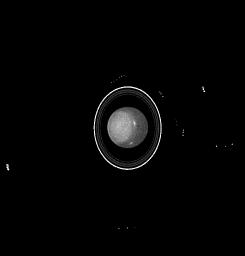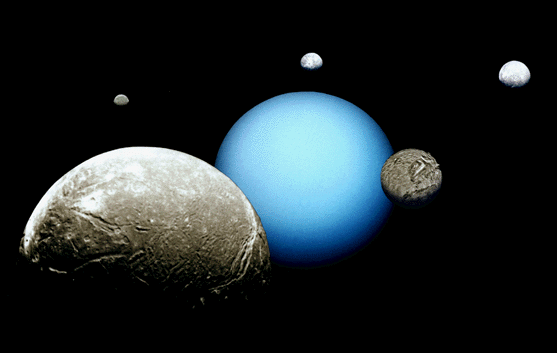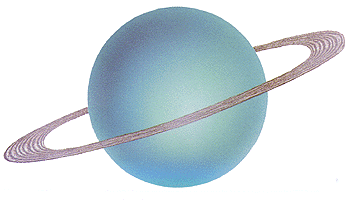|

QueSPER Research Projects
Planets in the Solar System
Uranus

Uranus
QueSPER Research Plan and
Note-taking Worksheets

|
 |
|
Uranus and some of its moons |
Uranus and its rings |
Uranus
Printout
 |
How far is
Uranus from the Sun?
 |
Uranus is the
seventh closest planet to the Sun. |
 |
Uranus is about
1.8 billion
miles or 2.8 billion kilometers from the
Sun. |
 |
Uranus is
19.218 AU* from the Sun. |
|
 |
How big is Uranus? (What is its diameter?)
 |
Uranus is the
third largest planet in the solar system. Jupiter and Saturn are larger.
|
 |
Uranus is
about four times larger than Earth. |
 |
Uranus's
diameter is 31,764 miles at the equator. |
|
 |
What does Uranus
look like?
 |
Uranus has
an atmosphere of hydrogen, helium and methane. |
 |
Uranus has a
temperature of -353° F. |
 |
Uranus has
27 moons.
Twenty-one of them have names; 6 do not. |
 |
Uranus has a
greenish-blue color. |
 |
Uranus was
probably knocked sideways by a collision with and Earth-size object. Now
Uranus rolls around the sun like a ball, while the other planets spin
around the sun like tops. |
|
 |
Why is this
planet named Uranus?
 |
Uranus is named
for an ancient Greek sky god. |
 |
Uranus was the
first planet to be discovered by telescope. It was discovered by William
Herschel on March 13, 1781. |
 |
Its name,
Uranus, was chosen to conform with the references to Greek and Roman
mythology of the other planets. The name did not come into common use until
1850. Before that is was called various names including Herschel, and The
Georgian Planet. |
|
 |
Can I see Uranus
in the night sky?
 |
Yes, but you
must have very sharp eyes. Most people use a telescope to see Uranus. To see
if it is visible now, check the
Sky
Maps. |
|
*One AU is the distance from the center of the Earth to the center of the
Sun.
Information on this page was taken from the following websites:
The-Solar-System.Net
Links to Other
Sites
Books and References
 |
| Time for Kids Almanac 2003 with
Information Please. NY: Time for Kids Books, 2002. |
RL 4.5 |
Dewey 031.02 |
|
 |
| Farndon, John. The Giant Book
of Space. Brookfield,CT: Copper Beech Bks, 2000. |
RL 4.5 |
Dewey 523.4 |
|
"The Solar System 12/2006: 8 Planets; The New Cosmic
Order." Map Insert. National Geographic Magazine. Dec., 2006.
Other Links to Sites
The Nine Planets-Uranus

 to QueSPER Online to QueSPER Online
|
![]()



![]()
 /
/